IdentityServer4-用EF配置Client(一)
一、背景
IdentityServer4的介绍将不再叙述,百度下可以找到,且官网的快速入门例子也有翻译的版本。这里主要从Client应用场景方面介绍对IdentityServer4的应用。
首先简要介绍ID Token和Access Token:
Access Token是授权第三方客户端访问受保护资源的令牌。 ID Token是第三方客户端标识用户身份认证的问令牌,是JSON Web Token格式。
二、Client应用场景介绍
Client类是为OpenID Connect或OAuth 2.0 协议建模的。
我们先看官网快速入门中给的Client例子
public static IEnumerable<Client> GetClients()
{
// client credentials client
return new List<Client>
{
new Client
{
ClientId = "Client",
AllowedGrantTypes = GrantTypes.ClientCredentials,
ClientSecrets =
{
new Secret("secret".Sha256())
},
AllowedScopes = { "api1" }
}, // resource owner password grant client
new Client
{
ClientId = "ro.client",
AllowedGrantTypes = GrantTypes.ResourceOwnerPassword, ClientSecrets =
{
new Secret("secret".Sha256())
},
AllowedScopes = { "api1" } }, // OpenID Connect hybrid flow and client credentials client (MVC)
new Client
{
ClientId = "mvc",
ClientName = "MVC Client",
AllowedGrantTypes = GrantTypes.HybridAndClientCredentials, ClientSecrets =
{
new Secret("secret".Sha256())
}, RedirectUris = { "http://localhost:5002/signin-oidc" },
PostLogoutRedirectUris = { "http://localhost:5002/signout-callback-oidc" }, AllowedScopes =
{
IdentityServerConstants.StandardScopes.OpenId,
IdentityServerConstants.StandardScopes.Profile,
"api1"
},
AllowOfflineAccess = true
}, // JavaScript Client
new Client
{
ClientId = "js",
ClientName = "JavaScript Client",
AllowedGrantTypes = GrantTypes.Implicit,
AllowAccessTokensViaBrowser = true, RedirectUris = { "http://localhost:5003/callback.html" },
PostLogoutRedirectUris = { "http://localhost:5003/index.html" },
AllowedCorsOrigins = { "http://localhost:5003" }, AllowedScopes =
{
IdentityServerConstants.StandardScopes.OpenId,
IdentityServerConstants.StandardScopes.Profile,
"api1"
},
}
};
}
里面主要介绍四种Client应用场景。
(1)客户端模式(AllowedGrantTypes = GrantTypes.ClientCredentials)
这是一种最简单的授权方式,应用于服务于服务之间的通信,token通常代表的是客户端的请求,而不是用户。
使用这种授权类型,会向token endpoint发送token请求,并获得代表客户机的access token。客户端通常必须使用token endpoint的Client ID和secret进行身份验证。
适用场景:用于和用户无关,服务与服务之间直接交互访问资源
(2)密码模式(ClientAllowedGrantTypes = GrantTypes.ResourceOwnerPassword)
该方式发送用户名和密码到token endpoint,向资源服务器请求令牌。这是一种“非交互式”授权方法。
官网上称,为了解决一些历史遗留的应用场景,所以保留了这种授权方式,但不建议使用。
适用场景:用于当前的APP是专门为服务端设计的情况。
(3)混合模式和客户端模式(ClientAllowedGrantTypes =GrantTypes.HybridAndClientCredentials)
ClientCredentials授权方式在第一种应用场景已经介绍了,这里主要介绍Hybrid授权方式。Hybrid是由Implicit和Authorization code结合起来的一种授权方式。其中Implicit用于身份认证,ID token被传输到浏览器并在浏览器进行验证;而Authorization code使用反向通道检索token和刷新token。
推荐使用Hybrid模式。
适用场景:用于MVC框架,服务器端 Web 应用程序和原生桌面/移动应用程序。
(4)简化模式(ClientAllowedGrantTypes =GrantTypes.Implicit)
Implicit要么仅用于服务端和JavaScript应用程序端进行身份认证,要么用于身份身份验证和access token的传输。
在Implicit中,所有token都通过浏览器传输的。
适用场景:JavaScript应用程序。
三、Server端搭建
为了介绍IdentityServer4的Client应用场景,我们需要先搭建IdentityServer服务端。
这里搭建的是使用EF Core来做数据操作,保存到SQL Server中。
(1)新建API项目
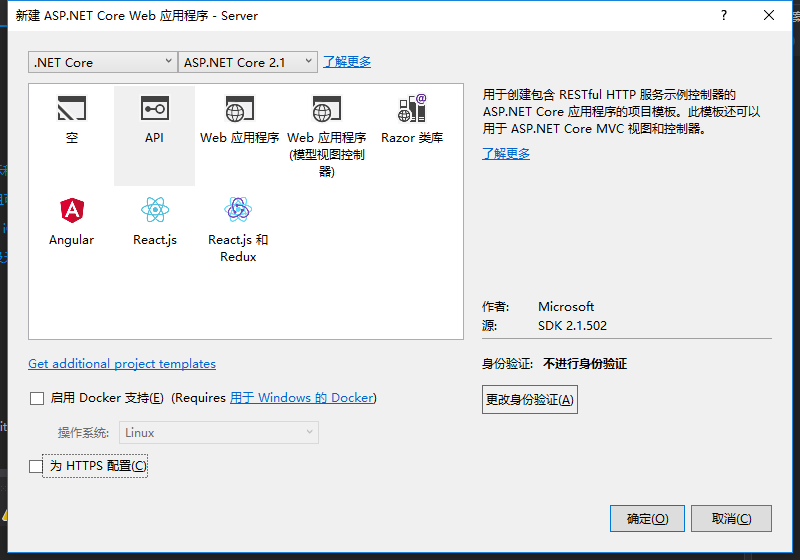
(2)安装IdentityServer4.EntityFramework包

(3)安装IdentityServer4包
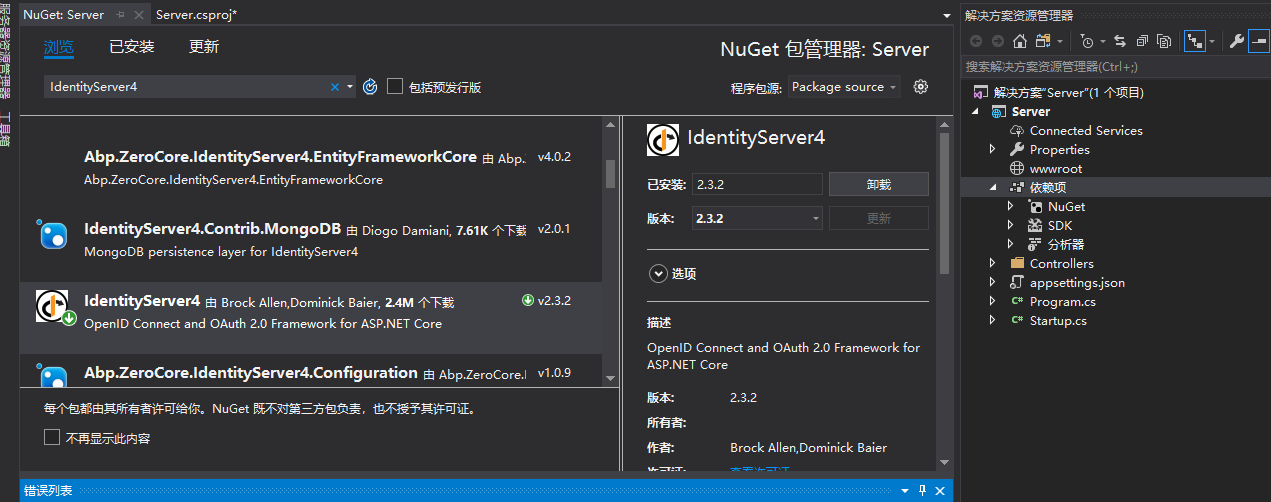
(4)右键项目的属性,编辑项目的.csproj文件
添加如下元素
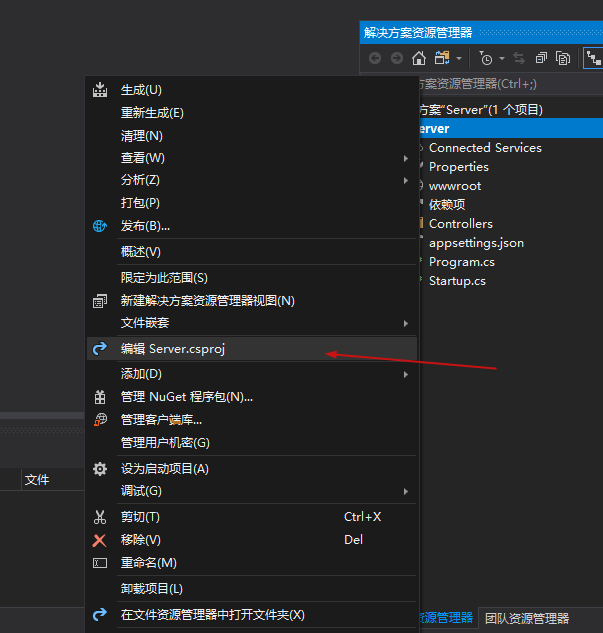
<ItemGroup>
<DotNetCliToolReference Include="Microsoft.EntityFrameworkCore.Tools.DotNet" Version="2.0.0" />
</ItemGroup>
如图:

(5)cmd管理员身份进入项目目录路径(D:\IdentityServer4\Server),运行:dotnet ef

(6)项目内添加Config.cs类,代码如下
public class Config
{
public static List<TestUser> GetUsers()
{
return new List<TestUser>
{
new TestUser
{
SubjectId = "",
Username = "alice",
Password = "password", Claims = new List<Claim>(){new Claim(JwtClaimTypes.Role,"superadmin") }
},
new TestUser
{
SubjectId = "",
Username = "bob",
Password = "password", Claims = new List<Claim>
{
new Claim("name", "Bob"),
new Claim("website", "https://bob.com")
},
}
};
} public static IEnumerable<Client> GetClients()
{
// client credentials client
return new List<Client>
{
new Client
{
ClientId = "Client",
AllowedGrantTypes = GrantTypes.ClientCredentials,
ClientSecrets =
{
new Secret("secret".Sha256())
},
AllowedScopes = { "api1" }
}, // resource owner password grant client
new Client
{
ClientId = "ro.client",
AllowedGrantTypes = GrantTypes.ResourceOwnerPassword, ClientSecrets =
{
new Secret("secret".Sha256())
},
AllowedScopes = { "api1" }
}, // OpenID Connect hybrid flow and client credentials client (MVC)
new Client
{
ClientId = "mvc",
ClientName = "MVC Client",
AllowedGrantTypes = GrantTypes.HybridAndClientCredentials, ClientSecrets =
{
new Secret("secret".Sha256())
}, RedirectUris = { "http://localhost:5002/signin-oidc" },
PostLogoutRedirectUris = { "http://localhost:5002/signout-callback-oidc" }, AllowedScopes =
{
IdentityServerConstants.StandardScopes.OpenId,
IdentityServerConstants.StandardScopes.Profile,
"api1"
},
AllowOfflineAccess = true
}, // JavaScript Client
new Client
{
ClientId = "js",
ClientName = "JavaScript Client",
AllowedGrantTypes = GrantTypes.Implicit,
AllowAccessTokensViaBrowser = true, RedirectUris = { "http://localhost:5003/callback.html" },
PostLogoutRedirectUris = { "http://localhost:5003/index.html" },
AllowedCorsOrigins = { "http://localhost:5003" }, AllowedScopes =
{
IdentityServerConstants.StandardScopes.OpenId,
IdentityServerConstants.StandardScopes.Profile,
"api1"
},
}
};
}
public static IEnumerable<IdentityResource> GetIdentityResources()
{
return new List<IdentityResource>
{
new IdentityResources.OpenId(),
new IdentityResources.Profile(),
};
} public static IEnumerable<ApiResource> GetApiResources()
{
return new List<ApiResource>
{
new ApiResource("api1", "My API")
};
}
添加引用:
using IdentityModel;
using IdentityServer4;
using IdentityServer4.Models;
using IdentityServer4.Test;
using System.Collections.Generic;
using System.Security.Claims;
(7)编辑Startup.cs文件的ConfigureServices方法,改成如下代码。
public void ConfigureServices(IServiceCollection services)
{
const string connectionString = @"Server=localhost;database=IdentityServer4;User ID=sa;Password=Pwd;trusted_connection=yes";
var migrationsAssembly = typeof(Startup).GetTypeInfo().Assembly.GetName().Name; // configure identity server with in-memory stores, keys, clients and scopes
services.AddIdentityServer()
.AddDeveloperSigningCredential()
.AddTestUsers(Config.GetUsers())
// this adds the config data from DB (clients, resources)
.AddConfigurationStore(options =>
{
options.ConfigureDbContext = builder =>
builder.UseSqlServer(connectionString,
sql => sql.MigrationsAssembly(migrationsAssembly));
})
// this adds the operational data from DB (codes, tokens, consents)
.AddOperationalStore(options =>
{
options.ConfigureDbContext = builder =>
builder.UseSqlServer(connectionString,
sql => sql.MigrationsAssembly(migrationsAssembly)); // this enables automatic token cleanup. this is optional.
options.EnableTokenCleanup = false;//是否从数据库清楚令牌数据,默认为false
options.TokenCleanupInterval = ;//令牌过期时间,默认为3600秒,一个小时
});
//.AddInMemoryClients(Config.GetClients());
services.AddMvc().SetCompatibilityVersion(CompatibilityVersion.Version_2_1);
}
添加引用:
using Microsoft.EntityFrameworkCore;
using System.Reflection;
(8)cmd管理员身份进入到项目目录路径(D:\IdentityServer4\Server\Server),注意,多了一层目录,分别运行以下两条指令:
dotnet ef migrations add InitialIdentityServerPersistedGrantDbMigration -c PersistedGrantDbContext -o Data/Migrations/IdentityServer/PersistedGrantDb dotnet ef migrations add InitialIdentityServerConfigurationDbMigration -c ConfigurationDbContext -o Data/Migrations/IdentityServer/ConfigurationDb

运行完后,项目中会多了一个Data文件夹
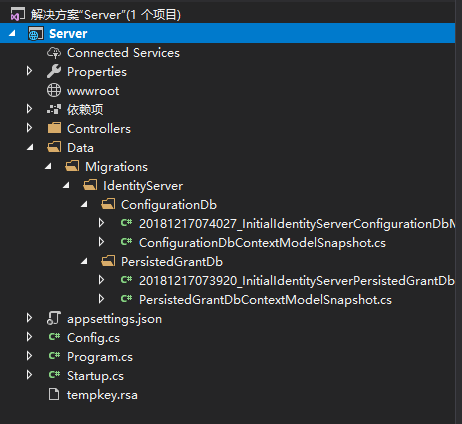
(9)在Startup.cs中添加初始化数据库方法。
private void InitializeDatabase(IApplicationBuilder app)
{
using (var serviceScope = app.ApplicationServices.GetService<IServiceScopeFactory>().CreateScope())
{
serviceScope.ServiceProvider.GetRequiredService<PersistedGrantDbContext>().Database.Migrate(); var context = serviceScope.ServiceProvider.GetRequiredService<ConfigurationDbContext>();
context.Database.Migrate();
if (!context.Clients.Any())
{
foreach (var client in Config.GetClients())
{
context.Clients.Add(client.ToEntity());
}
context.SaveChanges();
} if (!context.IdentityResources.Any())
{
foreach (var resource in Config.GetIdentityResources())
{
context.IdentityResources.Add(resource.ToEntity());
}
context.SaveChanges();
} if (!context.ApiResources.Any())
{
foreach (var resource in Config.GetApiResources())
{
context.ApiResources.Add(resource.ToEntity());
}
context.SaveChanges();
}
}
}
添加引用:
using IdentityServer4.EntityFramework.DbContexts;
using IdentityServer4.EntityFramework.Mappers;
(10)在Startup.cs中的Configure方法修改成以下代码。
public void Configure(IApplicationBuilder app, IHostingEnvironment env)
{
//if (env.IsDevelopment())
//{
// app.UseDeveloperExceptionPage();
//}
InitializeDatabase(app);
//app.UseMvc();
}
到这里,把项目以控制台形式运行
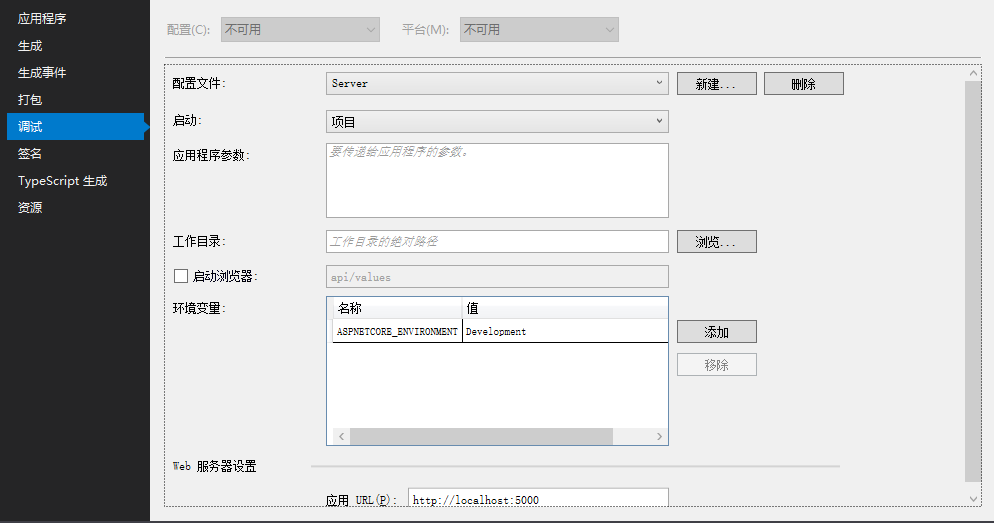

点击运行,可以跑起来,且生成数据库IdentityServer4DB。
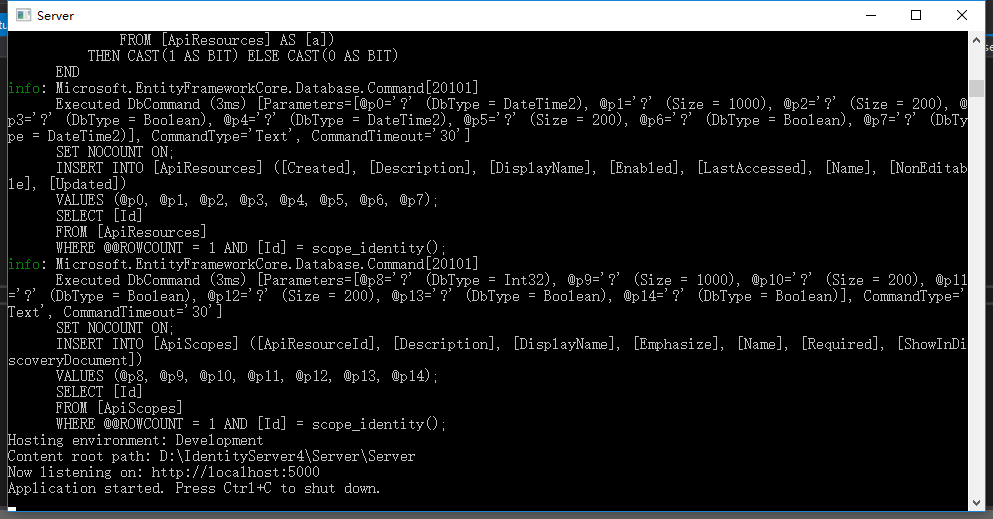

关于Client的说明可以查阅官网资料:https://identityserver4.readthedocs.io/en/release/reference/client.html
源码地址:https://github.com/Bingjian-Zhu/Server.git
服务端准备好之后,下篇文章开始介绍Client客户端的应用。
IdentityServer4-用EF配置Client(一)的更多相关文章
- 27.集成EFCore配置Client和API
copy链接字符串,这是一个官方的字符串,直接复制过来,放在上面. 添加包的引用 引入IdentityServer4.EntityFramework的命名空间 主要是这个地方初始化我们的数据库 Ope ...
- IdentityServer4-EF动态配置Client和对Claims授权(二)
本节介绍Client的ClientCredentials客户端模式,先看下画的草图: 一.在Server上添加动态新增Client的API 接口. 为了方便测试,在Server服务端中先添加swagg ...
- EF配置模型
配置方法 EF里面的默认配置有两个方法,一个是用Data Annotations(在命名空间System.ComponentModel.DataAnnotations;),直接作用于类的属性上面,还有 ...
- 从头编写 asp.net core 2.0 web api 基础框架 (4) EF配置
第1部分:http://www.cnblogs.com/cgzl/p/7637250.html 第2部分:http://www.cnblogs.com/cgzl/p/7640077.html 第3部分 ...
- 【转载】从头编写 asp.net core 2.0 web api 基础框架 (4) EF配置
Github源码地址:https://github.com/solenovex/Building-asp.net-core-2-web-api-starter-template-from-scratc ...
- EF 配置MySQL
添加 mysql dll 引用 WebConfig 配置: 1.先添加connectionstrings,providerName 换成 mysql的 <connectionStrings> ...
- EF 配置实现建表与迁移
通过EF 作为操作数据库的工具有一段时间了,也做了几个相对不大的项目,慢慢的也对EF的使用摸索出来了一些规则,虽然说不是技术难点,但是,我说的是但是,能够提高我们开发效率的棉花糖有时我们还是必须要吃的 ...
- 【甘道夫】Hadoop2.2.0 NN HA具体配置+Client透明性试验【完整版】
引言: 前面转载过一篇团队兄弟[伊利丹]写的NN HA实验记录,我也基于他的环境实验了NN HA对于Client的透明性. 本篇文章记录的是亲自配置NN HA的具体全过程,以及全面測试HA对clien ...
- 基于IdentityServer4的单点登录——Client
以MvcClient项目为例 1.新建项目并添加引用 新建一个asp .net core 2.0的项目引用IdentityModel 2.配置 比之前的控制台客户端多这个步骤,需要配置这个客户端的Cl ...
随机推荐
- SVN备份还原
本文是对SVN备份还原的一个简单记录 /*千万不能用VisualSVN Server PowerShell,否则在还原Load的时候会发生错误E140001,具体参考http://stackoverf ...
- Mybatis进阶学习笔记——关系查询——一对一查询
用户和订单的需求 通过查询订单,查询用户,就是一对一查询 (1)自定义JavaBean(常用,推荐使用) <select id="queryOrderUser" result ...
- 深层揭密extern "C"
一. extern "C" 包含双重含义,从字面上即可得到:首先,被它修饰的目标是“extern”的:其次,被它修饰的目标是“C”的.让我们来详细解读这两重含义. (1) 被ext ...
- 《Joint Face Detection and Alignment using Multi-task Cascaded Convolutional Networks》
<Joint Face Detection and Alignment using Multi-task Cascaded Convolutional Networks> 论文主要的三个贡 ...
- UML和模式应用4:初始阶段(5)--用例编写的准则
1.前言 本文主要介绍用例编写时所遵循的几条基本准则. 2.用例编写的准则 2.1 以本质的风格编写用例 如系统认证,而不要说 需要输入ID进行认证等 2.2 编写简洁的用例 如系统认证,不要说 这个 ...
- ubuntu下好用的音乐播放器audacious
audacious是ubuntu下一款非常好用的音乐播放器,万能的音乐播放器而且简洁美观,可以播放ape各种无损发烧音乐格式. 如果想听音乐的话,现在百度音乐,酷我音乐,酷狗音乐等都是有网络播放器的, ...
- VS "以下文件中的行尾不一致,要将行尾标准化吗?"
原文地址:http://www.cnblogs.com/yymn/p/6852857.html 这是由Windows和Unix不同的标准引起的...即“回车”和“换行”的问题... “回车”和“换行” ...
- mysql安装与卸载(非绿色版)
一.安装和卸载 Mysql安装路径: C:\Program Files\MySQL\MySQL Server 5.5\ Mysql数据文件存放的路径: C:\Documents and Setting ...
- echarts地图使用
在使用echarts3当中,地图需要的数据时分开的,需要自己下载,而在echarts3官网上的地图数据只有全国.中国.各省的地图 如果我们需要使用更详细的地图,需要在echarts2的生成需要的地级市 ...
- jquery之data()
$("#test").data("myProp","123") alert($("#test").data(" ...
